Commentaries on 6 Paul Celan Poems
Re: Tenebrae, White and Light, Speech-Grille,
Snowbed, Matière de Bretagne
& Rubble Scow
These are reduced translated versions, with some additional materials, of Barbara Wiedemann’s superb
KOMMENTAR in her Paul Celan: Neue kommentierte Gesamtausgabe. Die Gedichte (Suhrkamp 2018)
All poems taken from Sprachgitter | Speechgrille:
All poems in this 1959 volume were written between 3. 6. 1955 and 11. 3. 1958. Speechgrille is the smallest of Celan’s collections; the period in question — from which there exist only three poems not included in the volume — seems to be the one in which he wrote the least. Concerning this writing block, see also his letter to Hermann Lenz of 6. 24. 1956: “But believe me, I would have written a long time ago, if — I still could write. For I have such a wordless year behind me — behind me? —, that I have to doubt if this state will ever end.” (PC/HHL 49).
Concerning the title Sprachgitter |Speechgrille, see the poem of that name in the third cycle, the comments on it, & the letter to his editor, Rudolf Hirsch: “At the same time I tell myself that what speaks along with me in ‘Speechgrille’ is also the existential, the difficulty of all speaking (-to-each-other) and simultaneously its structure (cf. ‘ Raumgitter | spacegrille’), with which the at first seemingly amphibian is pushed back again — You see I’m still hesitating.” (7. 26. 1958, cf. Joachim Seng, p. 172). See also the note from the drafts for the Büchner prize speech: “The pictorial is by no means something visual; it is, like everything else connected with language, a mental phenomenon. […] It is, here too, a manifestation of language, a speech-art that has to be heard in the written, i.e. the silent (the language-grille, which is also the speechgrille, makes this visible.” (The Meridian, # 256, p. 107).
Tenebrae
3. 10. – 10. 8. 1957.
T Tenebrae] Lat. for darkness; cf. so in the Vulgata-Mt. 27.45: “A sexta autem hora tenebrae factae sunt super universam terram usque ad horam nonam | Now from the sixth hour there was darkness over all the land unto the ninth hour.” Tenebrae or Officium tenebrarum is the name of is a religious service of Western Christianity held during the three days preceding Easter, and characterized by gradual extinguishing of candles, and by a “strepitus” or “loud noise” taking place in total darkness near the end of the service. It is a catholic liturgy but one with marked Jewish features. In the Hebrew original four of the 5 lamentations (of 22 verses each) begin an alphabetic order with a consonant of the Hebrew alphabet (alphabetic acrostic); in the latin (catholic) version the Hebrew consonant is set as letter hame at the head of the verse and gives rise to specific coloratura in the musical settings. Cf. v. 10-11 of “Benedicta” (You, who greeted it, |the tenebrae lamp) and PC’s title for one of GCL’s etchings: “Ténèbres — Tenebrae.” In 1957, Easter fell on 21 April.
In Spur des Wortes, Otto Pöggeler recounts that when he visited Celan in April 1957, the poet told him that “Tenebrae” was “one of his favorite poems: that it had come to him on the street and that he was able to write it down complete when he got home — this hadn’t happened to him much recently. He himself was not a believer, but the poem was like a negro spiritual. Because of the hieratic character off the latin language he had not chosen the French title “Leçons des ténèbres” [Couperin’s Oratorium, a recording of which Celan owned & which Jean Bollack suggested as core inspiration for the poem]. Cf. also Felstiner’s discussion of the poem int PSJ, pp 101-105.
T Tenebrae, 1 f. Nah sind wir, Herr, | nah und greifbar || We are near, Lord, | near and at hand.] Cf. Hölderlin’s “Patmos:” “ Near and | hard to grasp, the god. | Yet where danger lies, | grows that which saves. | Eagles dwell | in darkness, and without fear” (Richard Sieburth’s translation, p. 89 Hymns and Fragments, Princeton UP, 1984).
4 ineinander verkrallt | clawed into each other] BW points to The Theory and Practice of Hell, where Eugen Kokon cites Oscar Berger’s account of Treblinka: “Sometimes there were shipments that held only corpses. I believe these people must have been gassed in the cars, for I never noticed any wounds. The bodies were convulsively intertwined, the skin blue.” (p.184) & the corroborative note by PC of 7. 18. 1965 in Richard Beer-Hofmann’ Jaácob’s Traum (Jacob’s Dream): “Ineinander verkrallt! | clawed into each other” next to Jacob’s acknowledgement to God: “Doch aneinander hangen, ewig — Du und ich! | But eternally hanging on each other — you & I.” (P. 148in the original).
6 dein Leib, Herr | your body, Lord, 14 Es war Blut, es war |was du vergossen, Herr ||It was blood, it was | what you spilled, Lord] Cf. Matthew 26.28: “For this is My blood of the new covenant, which is shed for many for the remission of sins.” & v. 11 of “ The Load:” “Curry my horse, when the hand here breaks the bread.”
12 Mulde und Maar | crater and maar] Various reading notes & word lists in the Tübingen philological edition of Sprachgitter cites Mulde |crater in connection with glacier formations (TCA/SG 114) & Maar |maar in relation to volcanic formations as given in the Kluge-Götze etymological dictionary of the German language (TCA/SG 120, zu S. 254).
13 Zur Tränke |To the trough] Tränke | trough (watering place)] the word appears only one other time in Celan’s work, in v. 12 of “The Load.”
18 Augen und Mund stehn so offen und leer |Eyes and mouths gape, so open and empty] Cf. Celan’s translation of Cayrols text for Alain Resnais’ Auschwitz film Nacht und Nebel | Night and Fog: “Zuletzt haben alle das gleiche Gesicht. Es sind alterslose Wesen, die mit offenen Augen sterben |At the end, they all have the same face. They are ageless creatures that die with their eyes open.” (GW IV 89).
Weiß und Leicht | White and Light
10. 23. 1956 – 10. 8. 1957.
On 10. 17. 1957 Celan sent this poem together with “Night,” “With Letter and Clock,” “Snowbed,” and “Matière de Bretagne,” to Ingeborg Bachmann with the following explanation: “I am sending you a few poems, Ingeborg, read them. / There is barely a poem in which I didn’t leave room for you. That space is the truth of the poems. / When I wrote ‘White and Light’ — it took days and days —, there came, at the very last, the word ‘Verlorne |lost one.’ I knew immediately that that was you, I tried to defend myself — but you had to stay, for truth’s sake.” (Die Zeit, 4. 28. 2016, p. 48, PC/IB, letter #55, p. 73)
2 Im Windschatten |In the windshadow] In a reading note of 9.21. 1954 PC had marked this sentence in Heidegger’s What is Called Thinking: “. . . Sokrates sei der reinste der Denker des Abendlandes, die Nachfolger hätten sich in den Windschatten stellen müssen.” [The English translation by J. Glenn Gray renders this as “… those who followed had to run for shelter.”]
6 Die Strahlen. Sie wehn uns zuhauf. |The rays. They blow us into a heap] Cf. Celan’s confirming note, “The rays. They blow us into a heap” in Relation to Scholem writing in Die Geheimnisse der Schöpfung | The secrets of Creation [not translated as far as I could discover]: “Das Strahlen – das ist das geheime Licht, in dem die Tora erstrahlt und das die Häupter der [von Jecheskel erschauten Tiergestalt] erleuchtet. Diese ›Häupter‹ aber sind nichts anderes als die ›Einsichtigen‹ [im Buche Daniel], die immerdar leuchten und jenes ›Gewölbe‹ und das Leuchten, das von dort ausgeht, einsichtig betrachten. Dies aber ist das Licht der Tora, das immerdar und unaufhörlich leuchtet” (p. 50). [“The radiating — that is the secret light the Torah radiates and that lights the heads (seen by Ezekiel as animal-shapes.) These ‘heads,’ however are nothing else than the wise men [in the Book of Daniel]…This however is the light of the Torah which radiates always and endlessly.” Cf. also v. 2 of “Eroded | Weggebeizt:” “the beamwind.”
23 f. Die Stirnen | die man uns lieh, | um der Spiegelung willen ||the foreheads that were lent us, | for the sake of the mirrorings ] Cf. PC’s note in Scholem’s Die Geheimnisse der Schöpfung , “the forehead that were lent us, | for the sake of the mirrorings | (White and light)” in connection with Scholem’s phrase: “The Shekinah has nothing of its own. But she receives and safekeeps everything and rules with her, as it is often called, ‘lent’ strength in the below. [Die Schechina hat nichts aus sich selbst. Sie empfängt und bewahrt aber alles und waltet mit dieser ihr, wie es oft heißt, ‘geliehenen’ Kraft im Unteren.”] (further marginal marks, p. 36 f., the note p. 37).
30 Meermühle geht | Seamill turns] Cf. the unidentified reading note: “Auskolkung, Kolk, Vertief[un]g in der Sohle eines Flusses (Strudellöcher) an Meeresküsten (Meermühlen) oder im Untergrund von Gletschern | scouring, scour, hollow in a riverbed (scour holes) on seacoasts (sea-mill) or in the underground of glaciers” (TCA/SG 114). Clemens Podewils (as recalled by Pajari Räsänen in his Counter-figures: An Essay on Anti-metaphoric Resistance. Paul Celan’s Poetry ) reported the following comment by Celan concerning the word Meermühle: “These compound nouns have been held against me, for exemple Meermühle |seamill. But aren’t pebbles, rocks, cliffs ground by the sea into what they are?… Basically my word formations are not inventions. They belong to the oldest layers of language. What matters for me? To get away from words as simple descriptions. I would like to again hear the name of things in the words. The description isolates the presented object. In the name, however, each things speaks to us in its connection (Zusammenhang: coherence) with the world.”
Sprachgitter | Speech-Grille
6. 14. 1957(Vienna, Rennweg) – 0. 18. 1957 (dated corrections). Celan’s friends Klaus and Nanni Demus whom he visited during his holidays in Austria (cf. also “Voices”) lived in the Rennweg, the third district of Vienna.
T Sprachgitter | Speech-grille] Also title of volume. In Vienna Celan received a postcard dated “Whitsuntide 1957” (6.9.1957) from Günther Neske with the image of the confessional screen (the Sprechgitter) of the Saint Clare covent in Pfullingen (Württemberg); the text spoke to Celan’s intention of publishing his next book with Neske. Cf. marginal mark in Jean-Paul’s Kampaner Thal: “… unter dem tiefer einsinkenden Gewitter schlugen die Nachtigallen lauter, gleichsam als lebendige Gewitterstürmer, hinter blühenden Sprachgittern |… under the fast approaching storm the nightingales raised their voices, as if they were living lightning stormers, behind blooming speech-grilles.” (Bd. 42/43, S. 20, my translation as the available English translation avoids “Sprachgittern” & translates it as “hedges.”) Celan told Demus that those were the two inspirations for the title. He wrote his friend Joachim Seng, “I tell myself that in ‘Sprachgitter’ the existential, the difficulty of all speaking (to one another) and at the same time the structure of that speaking is what counts” (Gedichte 643).
1-4 Augenrund zwischen den Stäben. || Flimmertier Lid | rudert nach oben, | gibt den Blick frei. || Eyeround between the bars. || Flitterbug lid | rows upward,, | frees a gaze] Cf. Rilke’s famous poem “The Panther,” in New Poems: “His gaze against the sweeping of the bars |has grown so weary, it can hold no more. | To him, there seem to be a thousand bars | and back behind those thousand bars no world.” & further on: “An image enters then, | goes through the tensioned stillness of the limbs — | and in the heart ceases to be.“ (translated by Stanley Appelbaum.)
6 der Himmel, herzgrau, muß nah sein |the heavens, heartgrey, must be near.] Cf. the note to the Büchner speech: “Artistry and word-art — that may have the feeling of something occidental, evening-filling, Poetry is something else; poetry, heartgrey, sublunar, heavens- and heart-grey, heart and heavens-grey breath-marbled language in time. (M p.110)
7 Tülle | socket] Celan had many notes from various dictionaries, plus French translations, concerning this word essentially referencing the metal holder into which one sticks a light, also “Lichthalter | lightholder.”
13 unter einem Passat | under one trade wind ] Celan’s Kluge/Götze dictionary defines the “Passat” trade wind thus: “These easterly winds blowing regularly in the lower latitudes are beneficent for crossings.”
17 Lachen |pools] Marjorie Perloff writes in “‘Sound Scraps, Vision Scraps’: Paul Celan’s Poetic Practice,” her analysis of the poem: “Lachen, in this context, has the primary meaning of puddles or pools: two gray pools of water blot the flagstones. But Lachen also means “notches”—the stones are notched with the sign of the two unknown strangers — and in the singular, the noun “Lachen” is the common word “laughter”—in this case, a mirthless, hollow chuckle of sorts. In all three cases, the flagstones reflect the “heartgray” condition of the lovers: the desire for communion — with hidden priest? God? and especially the “you” who is his beloved — has failed.
18, 19 zwei | Mundvoll Scgweigen ||Two | mouthfuls of silence.] As Dennis J. Schmidt puts it, Celan’s “ ‘Two mouthfuls of silence’ (zwei / Mundvoll Schweigen) . . . mark the place of the poem for Celan . . . such silence is not to be confused with mere quiet but needs to be heard as the unvocalized voice of the poem. . . . a voice estranged from language, rendering the effort to listen to language in the poem rare, demanding, and painful at once.” (Dennis J. Schmidt, “Black Milk and Blue: Celan and Heidegger on Pain and Language,” in Hamacher 110-29; see p. 110.)
Schneebett | Snowbed
6. 23. (Zürich) – 10. 8. 1957. First fragments as notes in Arno Schmidt’s Leviathan, where further fragments point to “Voice IV” and “Embankments, Roadsides, Vacant Lots, Rubble.”
1, 9 Sterbegeklüft | death cliffs, 4 Steilwand | rockwall] Cf. reading traces in Arno Schmidt’s story “Enthymesis” in the volume Leviathan: with marginal arrow-mark by PC: “Als er durch Felsengewirr sich bis an ihren Fuß gearbeitet hatte, sah er bestürzt die wilden Mauern unabsehbar nach beiden Seiten laufen; Geröllhalden körnten blockig vor; lange Schatten hingen verrenkt im schweigenden Geklüft; himmelhoch neigte sich die Wand über den Zurücktaumelnden | He finally worked his way on foot to its base through a rock jumble, but to his dismay he saw no end to the wild wall on either side; before him pebbled slopes bouldered away in kernels; long, wrenched shadows hung in silent fissures; the sky-wall bent low over his reeling figure (p. 17 in English edition of Collected Novellas, translated by John E. Woods). See also the note from Celan’s June 1957 stay in Vienna: “Seelengeklüft | “ with the addition: “Vienna: Sterbehaus |Deathhouse” (TCA/SG 116). Re “Steilwand | cliff” cf. Enthymesis : “Der Führer deutete auf eine etwa 1 Stadion hohe rötliche Steilwand und wisperte schüchtern: ›Da soll es sein . . .’ |The guide pointed out a reddish cliff about 1 stadion high and whispered timidly: ‘That’s it, they say…’” (p. 6 in English edition).
1, 3 Ich komm |I come] Temporarily considered as title for the poem.
2 Hartwuchs im Herzen | Hardgrowth in the heart, 18 In den Gängen | In the passageways] cf. reading traces in the story “Nadir” in Leviathan: “ Now there running down the halls. — And I bounded up the mountains through the crouching, frozen tree shapes. (“Give us good going, ye, gravel, granite and hard stuff…” P. 60 in English translation. I prefer to translate “Gänge” with passageways rather the hall, and “ “Hartwuchs” as hard growth rather than “hard stuff.”) Celan had a note in the back of the book: “Hartwuchs im Herzen | hardgrowth in the heart.”
5 Atemgefleckted Geleucht. Strichweise Blut | Breathflecked light glow. Blood streaks] Cf. “Nadir” (with marginal mark): “Herbstnebel dampft auf | am hellen Mittag; warm und dicht, grünlich vom verwischten Pflanzengeleucht: nun findet ihr mich nicht mehr | Autumn fog billows up | in the bright afternoon: warm and thick, greenish from the gloss wiped off plants: you won’t find me now” and the note int he book: “Atemgeflecktes Geleucht. | Strichweise Blut | Breathflecked light glow. Blood streaks” and “– Hinab durchs Geleucht | — down through the lightglow.”
6 Atemgefleckted Geleucht. Strichweise Blut |Wölkende Seele, noch einmal gestaltnah. | Zehnfingerschatten – verklammert. || Breathflecked ligthglow. Blood streaks. |Clouding soul, once more near-shapely | Tenfinger shadow. Gripclasped ] Cf. notes in Leviathan: “Wölkende Seele, gestaltmüd | Wölkende Seele, noch einmal gestaltnah. | Zehnfingerschatten – verklammert || Clouding soul, shape-tired | Clouding soul, once more near-shapely |Tenfinger-shadow. Gripclasped”.
12f. Kristall um Kristall |zeittief gegittert, | Crystal after crustal, | meshed timedeep] Cf. note in Leviathan: “Crystal after crystal, | meshed timedeep” and Lotze’s term “Raumgitter | spacegrille” for the inner structure of crystals. (p. 17).
Matière de Bretagne
Paris, 8. 9/10. 1957 from fragments dated August 1956 and corrections datted 5. 17. 1957. PC himself indicated 8. 13. 1957 as date of composition. Probably the first poem began (5. 17. 1957, according to earlier notes) after PC acquired his first major Mandelstam edition (Cobranie covinenij [ Collected Works]) in May 1957. Draft also stands in close connection with PC’s translation of Rimbaud’s “Drunken Boat.” Cf. also commentary on “White and Light,” re Ingeborg Bachmann.
T Matière] The french word “matière” means material, matter, theme; with possible additions of: pus, excrements, brainmass. Cf. Celan’s remarks to Walter Jens: “Where there are such re-encounters, they affirm themselves also language-wise…: semantically — as in the case of the synonymity of ‘matière’ and ‘pus’ which was detected by you (and, tellingly, not by me), or, but that is rarer, in the etymological.” (16. 5. 1961, GA 532).
T Bretagne] From 4. 26. to 5. 1. 1957 Celan was in the celtic landscape of Brittany on the French Atlantic coast; a range of further poems & the ‘breton cycle’ in Noone’s Rose were written there (cf. “Die hellen Steine| The bright stones” & commentary )
T Matière de Bretagne] On 1. 23. 1961, PC told Norbert Koch that there was a connection with the breton King Arthur cycle of tales, pointing also back to the use of “Avalun |Avalon” from an early (not reproduced here) poem (“Flügelrauschen”) in SU. In connection with that poem, PC explained to Beda Alleman: “ I am including with these lines an old poem, that was doubtlessly a precursor of the later poem — in memory of Crozon and – among other things also – of the red sails of the Breton fishermen (‘Matière’). Back then – Avalon … – it was still called: ‘Flügelrauschen’” (3. 27. 1962, ref. Badiou).
1, 23 Ginsterlicht | Gorselight, 2 Dorn | thorn] Gorse (Ulex europaeus), the only Fabaceaee species with thorns, flowers golden-yellow from April to July.
10 beim Stern, die milchigen | next to the star, the milky] Cf. in PC’s translation of Rimbaud’s “Drunken Boat:” “Grünhimmel trank ich, Sterne, taucht ein in milchigen Strahl | [lit:] Greenskies I drank, stars, infused in milky beam” where the original is: “… je me suis baigné dans le Poème / De la mer, infusé d’astres, et lactescent, / dévorant les azurs verts;…] (on 7. 30. 1957; v. 22, GW IV 103).
11 f. Steindattel, | unten, gebuscht, klafft || stone-mussel | below, tufted, gapes] Pc noted the expression “Steindattel klafft” several times (TCA/SG 118), also in his Brehm (Brehms Tierleben in 4 Bänden, 1956) the description of the Mytilidae (Vol. 1, p. 135). The ref. here is to the date mussel (“Steindattel | stone-date” in German), Lithophaga, a genus of medium-sized marine bivalve molluscs in the family Mytilidae. Some of the earliest fossil Lithophaga shells have been found in Mesozoic rocks. The shells of species in this genus are long and narrow with parallel sides. The animals bore into stone or coral rock with the help of pallial gland secretions, hence the systematic name Lithophaga, which means “stone-eater”. (cf. Wikipedia) When the valves of a mussel are stand open (“gape”) the animal is dead. Cf. also v.8 of “Kermovan.”
16 Hände | hands] Cf. in PC’s letter to Norbert Koch: “ ‘hands,’ — those are… the hands, both hands, the ledt and the right, it is — I’m quoting Osip Mandelstam — (all!) our ‘Zweihändertum |twohandedness-state.”
Schuttkahn | Rubble Scow
5. 10. – 6. 10.1957. A later copy made specifically for Ingeborg Bachman on 10. 18. 1957 is entitled “Rheinufer | Rhine-shore” (HKA 5, 2, 227); re Celan’s stay in Köln, see the poem “Köln, Am Hof.”
3 f. ein totes|Warum steht am Heck | a dead | Why stands at the stern] 6, Geleichtert. Die Lunge | Lightened. The lung] Cf. reference in v. 23 & 26 of “Es ist alles anders | Everything is different.”
6 f. Die Lunge, die Qualle | bläht sich zur Glocke | The lung, the jellyfish | swells into a bell ] Celan probably read this in his Brehm: “Another type of jellyfish is the Lungenqualle [lung-jellyfish] (Rhizostoma pulmo), which inhabits the Mediterranean. It’s tender yellow bell can reach a diameter of 60 to 80 centimeters.” (v. 1, p. 51).


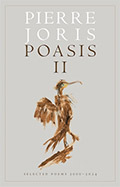 Poasis II: Selected Poems 2000-2024
Poasis II: Selected Poems 2000-2024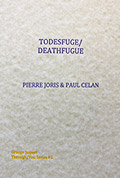 “Todesguge/Deathfugue”
“Todesguge/Deathfugue”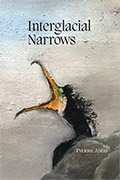 “Interglacial Narrows (Poems 1915-2021)”
“Interglacial Narrows (Poems 1915-2021)”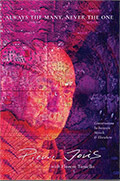 “Always the Many, Never the One: Conversations In-between, with Florent Toniello”
“Always the Many, Never the One: Conversations In-between, with Florent Toniello”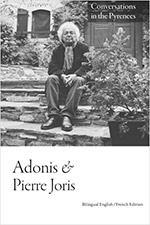 “Conversations in the Pyrenees”
“Conversations in the Pyrenees”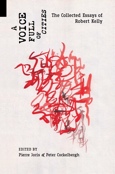 “A Voice Full of Cities: The Collected Essays of Robert Kelly.” Edited by Pierre Joris & Peter Cockelbergh
“A Voice Full of Cities: The Collected Essays of Robert Kelly.” Edited by Pierre Joris & Peter Cockelbergh “An American Suite” (Poems) —Inpatient Press
“An American Suite” (Poems) —Inpatient Press “Arabia (not so) Deserta” : Essays on Maghrebi & Mashreqi Writing & Culture
“Arabia (not so) Deserta” : Essays on Maghrebi & Mashreqi Writing & Culture “Barzakh” (Poems 2000-2012)
“Barzakh” (Poems 2000-2012) “Fox-trails, -tales & -trots”
“Fox-trails, -tales & -trots”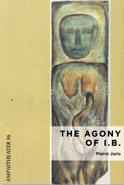 “The Agony of I.B.” — A play. Editions PHI & TNL 2016
“The Agony of I.B.” — A play. Editions PHI & TNL 2016 “The Book of U / Le livre des cormorans”
“The Book of U / Le livre des cormorans”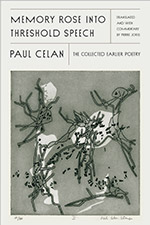 “Memory Rose Into Threshold Speech: The Collected Earlier Poetry of Paul Celan”
“Memory Rose Into Threshold Speech: The Collected Earlier Poetry of Paul Celan”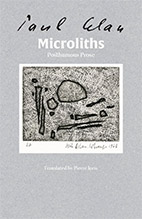 “Paul Celan, Microliths They Are, Little Stones”
“Paul Celan, Microliths They Are, Little Stones”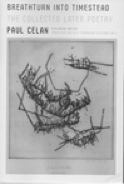 “Paul Celan: Breathturn into Timestead-The Collected Later Poetry.” Translated & with commentary by Pierre Joris. Farrar, Straus & Giroux
“Paul Celan: Breathturn into Timestead-The Collected Later Poetry.” Translated & with commentary by Pierre Joris. Farrar, Straus & Giroux
Thank you, Pierre, for this wonderfully illuminating material and translations. I just searched for your translations of the 6 poems on your blog, but I fear I’m a day late… Are they still available to view? (This is my first foray into blog-dom).
Yes, of course, the blog stays there with all the previous entries available — you can go to the search pix in the top right corner, type celan & you’ll get all the Celan posts. Or in the left hadn’t you corner, click on the word “Nomadic” which is a link, & you’ll get all the latest posts that will then be individually clickable.
P.S. Love the “Strahlen” illumination – the Torah resonances and the reverberations through to the later “Weggebeizt.”
Re. “Speech-Grille” – I was thinking, too, how those lines from Rilke’s “The Panther” reverberate through Celan’s “Conversation in the Mountains”: “they have eyes, but with a veil hanging in front of them, no, not in front, behind them, a moveable veil. No sooner does an image enter than it gets caught in the web… and begets a child, half image, half veil.”
Dear Pierre Joris, thank you for posting these commentaries, and for the 6 poems you shared in commemoration of 50 years since Celan’s death. Both your translations and these commentaries are an invaluable reference for me — I am finalising my Malay-language translations of selected poems by Celan, which is scheduled to be published in Malaysia later this year. I now see that I really must get hold of Barbara Wiedemann’s Paul Celan: Neue kommentierte Gesamtausgabe, I shall try to oder it. Translating Celan into Malay presents some intriguing challenges, but I think (hope) that Celan’s poems carry over beautifully into Malay. It’s affirming to be able to refer to your masterful English translations, especially at moments when the original German is unyielding. I look forward very much to your forthcoming Celan translations.
With best wishes from Kuala Lumpur.